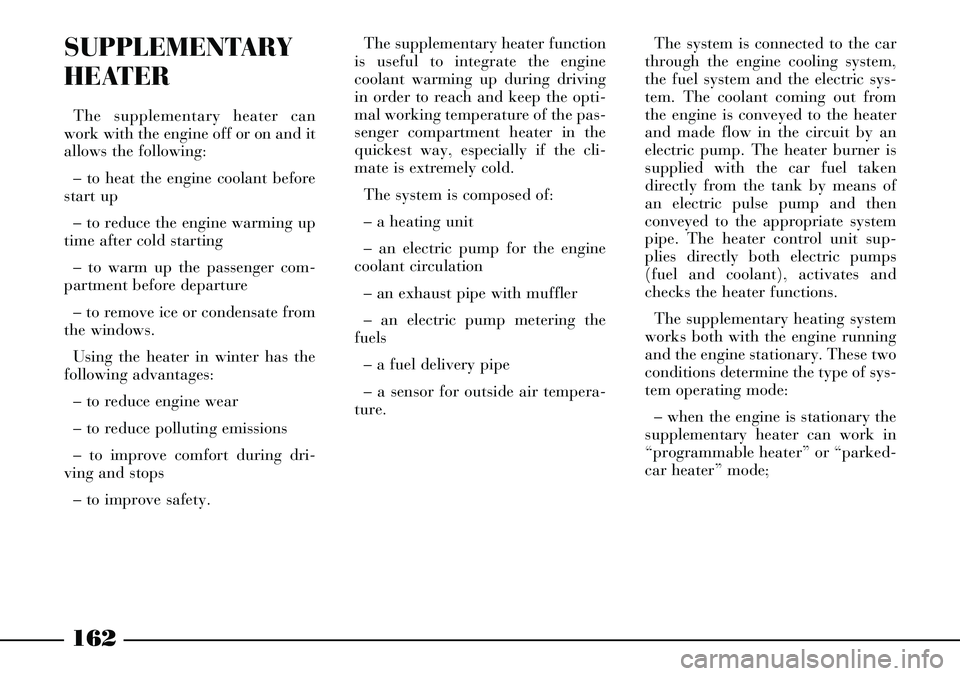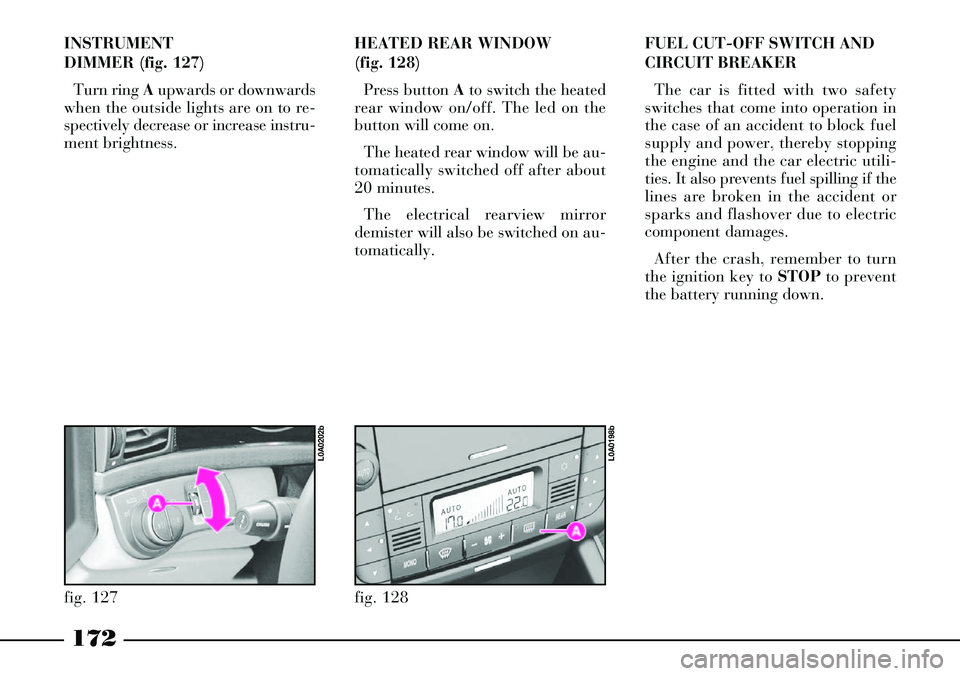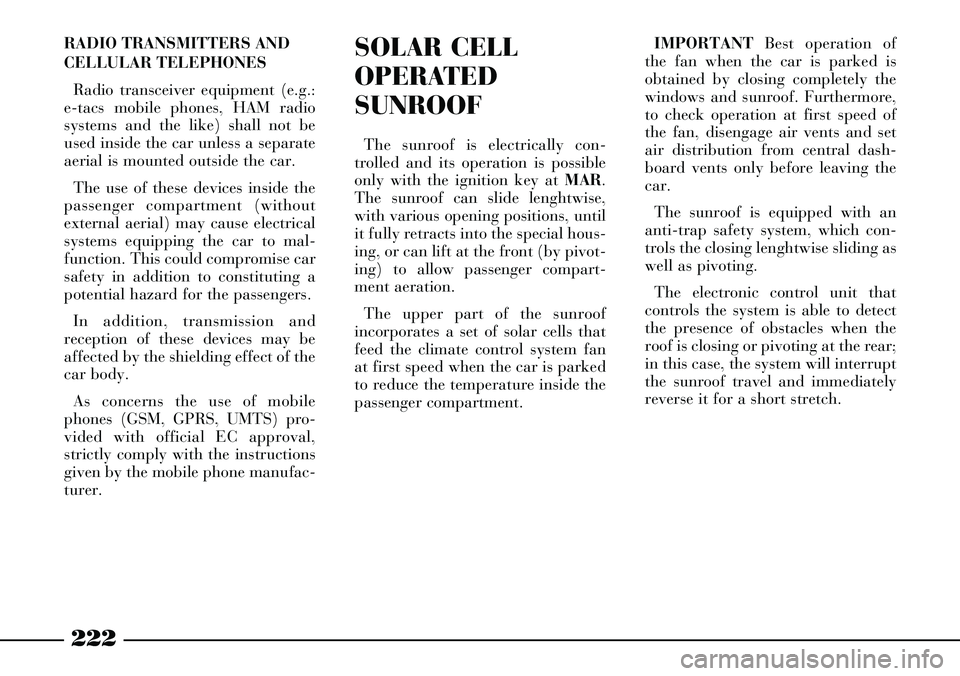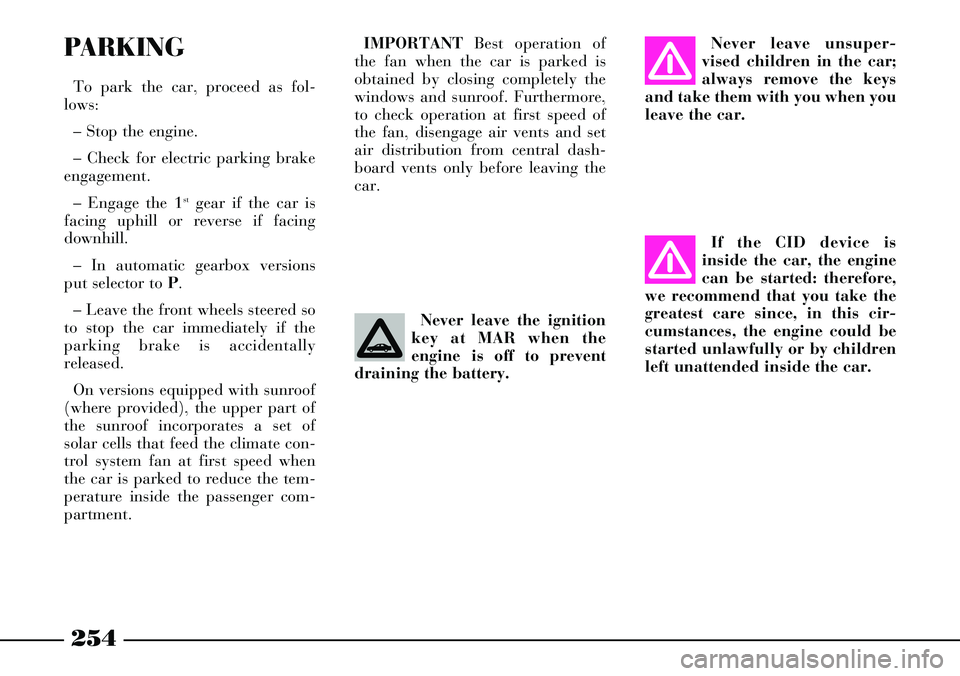window Lancia Thesis 2006 Owner handbook (in English)
[x] Cancel search | Manufacturer: LANCIA, Model Year: 2006, Model line: Thesis, Model: Lancia Thesis 2006Pages: 386, PDF Size: 8.69 MB
Page 162 of 386

161
ACTIVE CARBON
DUST/POLLEN FILTER
The filter has the specific capacity
of combining a mechanical air
cleaning action and an electrostatic
effect so that the air let into the pas-
senger compartment is purified from
particles such as dust, pollen, etc.
In addition to this function, the fil-
ter efficaciously reduces the concen-
tration of pollutants thanks to a
layer of active carbon inside the fil-
ter.
The filtering action is carried out
on the air let in from outside (recir-
culation off).
Have the filter checked at least
once a year at a Lancia
Dealership, ideally at the begin-
ning of the summer.The efficacy of the cli-
mate control system may
be considerably reduced
if the filter is not replaced.Fan actuation is automatic and air
distribution corresponds to the latest
setting made before switching the
car off.
This function is useful especially on
summer days since it greatly reduces
the temperature inside the passenger
compartment as well as the duration
of the cooling cycle after car start-
up, thus avoiding the accumulation
of warm air in the air conditioning
unit lines.
IMPORTANTBest operation of
the fan when the car is parked is
obtained by closing completely the
windows and sunroof. Furthermore,
to check operation at first speed of
the fan, disengage air vents and set
air distribution from central dash-
board vents only before leaving the
car.You should have the filter checked
and if required replaced more fre-
quently if the car is mainly used in
polluted or dusty areas.
VENTILATION DURING A STOP
In versions with sunroof, the roof
top features 21 photovoltaic cells
supplying a maximum power of 24
W to supply the climate control sys-
tem fan when the car is parked with
the roof closed or horizontally pivot-
ing.
Page 163 of 386

162
SUPPLEMENTARY
HEATER
The supplementary heater can
work with the engine off or on and it
allows the following:
– to heat the engine coolant before
start up
– to reduce the engine warming up
time after cold starting
– to warm up the passenger com-
partment before departure
– to remove ice or condensate from
the windows.
Using the heater in winter has the
following advantages:
– to reduce engine wear
– to reduce polluting emissions
– to improve comfort during dri-
ving and stops
– to improve safety.The supplementary heater function
is useful to integrate the engine
coolant warming up during driving
in order to reach and keep the opti-
mal working temperature of the pas-
senger compartment heater in the
quickest way, especially if the cli-
mate is extremely cold.
The system is composed of:
– a heating unit
– an electric pump for the engine
coolant circulation
– an exhaust pipe with muffler
– an electric pump metering the
fuels
– a fuel delivery pipe
– a sensor for outside air tempera-
ture.The system is connected to the car
through the engine cooling system,
the fuel system and the electric sys-
tem. The coolant coming out from
the engine is conveyed to the heater
and made flow in the circuit by an
electric pump. The heater burner is
supplied with the car fuel taken
directly from the tank by means of
an electric pulse pump and then
conveyed to the appropriate system
pipe. The heater control unit sup-
plies directly both electric pumps
(fuel and coolant), activates and
checks the heater functions.
The supplementary heating system
works both with the engine running
and the engine stationary. These two
conditions determine the type of sys-
tem operating mode:
– when the engine is stationary the
supplementary heater can work in
“programmable heater” or “parked-
car heater” mode;
Page 173 of 386

172
INSTRUMENT
DIMMER (fig. 127)
Turn ring Aupwards or downwards
when the outside lights are on to re-
spectively decrease or increase instru-
ment brightness.HEATED REAR WINDOW
(fig. 128)
Press button Ato switch the heated
rear window on/off. The led on the
button will come on.
The heated rear window will be au-
tomatically switched off after about
20 minutes.
The electrical rearview mirror
demister will also be switched on au-
tomatically.
fig. 127
L0A0202b
fig. 128
L0A0198b
FUEL CUT-OFF SWITCH AND
CIRCUIT BREAKER
The car is fitted with two safety
switches that come into operation in
the case of an accident to block fuel
supply and power, thereby stopping
the engine and the car electric utili-
ties. It also prevents fuel spilling if the
lines are broken in the accident or
sparks and flashover due to electric
component damages.
After the crash, remember to turn
the ignition key to STOPto prevent
the battery running down.
Page 220 of 386

219
REAR BOTTLE/CAN HOLDER
(fig. 178)
Bottle/can holder Ais incorporated
in the rear armrest.
To open it, press on the point spec-
ified by the arrow, then release it:
the bottle/can holder will automati-
cally open.
To close the bottle/can holder,
push it into its seat.REAR ARMREST
COMPARTMENT
Inside the rear armrest is an odd-
ment compartment A(fig. 179), a
card holder Band a power socket C.
Depending on versions, the armrest
can also include:
– the control buttons for heating,
massage, lumbar adjustment and for
adaptation of rear side seats
– the button to shift the front pas-
senger’s seat
– the button to actuate the electric
window shades
fig. 178
L0A0073b
fig. 179
L0A0075b
fig. 177
L0A0252b
CENTRAL CONSOLE
COMPARTMENT (fig. 177)
Versions with automatic, two-zone
climate control system are provided
with an oddment compartment A,
placed on the rear part of the central
console.
Page 223 of 386

222
SOLAR CELL
OPERATED
SUNROOF
The sunroof is electrically con-
trolled and its operation is possible
only with the ignition key at MAR.
The sunroof can slide lenghtwise,
with various opening positions, until
it fully retracts into the special hous-
ing, or can lift at the front (by pivot-
ing) to allow passenger compart-
ment aeration.
The upper part of the sunroof
incorporates a set of solar cells that
feed the climate control system fan
at first speed when the car is parked
to reduce the temperature inside the
passenger compartment.IMPORTANTBest operation of
the fan when the car is parked is
obtained by closing completely the
windows and sunroof. Furthermore,
to check operation at first speed of
the fan, disengage air vents and set
air distribution from central dash-
board vents only before leaving the
car.
The sunroof is equipped with an
anti-trap safety system, which con-
trols the closing lenghtwise sliding as
well as pivoting.
The electronic control unit that
controls the system is able to detect
the presence of obstacles when the
roof is closing or pivoting at the rear;
in this case, the system will interrupt
the sunroof travel and immediately
reverse it for a short stretch. RADIO TRANSMITTERS AND
CELLULAR TELEPHONES
Radio transceiver equipment (e.g.:
e-tacs mobile phones, HAM radio
systems and the like) shall not be
used inside the car unless a separate
aerial is mounted outside the car.
The use of these devices inside the
passenger compartment (without
external aerial) may cause electrical
systems equipping the car to mal-
function. This could compromise car
safety in addition to constituting a
potential hazard for the passengers.
In addition, transmission and
reception of these devices may be
affected by the shielding effect of the
car body.
As concerns the use of mobile
phones (GSM, GPRS, UMTS) pro-
vided with official EC approval,
strictly comply with the instructions
given by the mobile phone manufac-
turer.
Page 226 of 386

225
CENTRAL SUNROOF AND
WINDOW LOCKING SYSTEM
Central locking/opening of sunroof
and windows can be actuated at the
following conditions:
– ignition key removed
– all doors closed correctly.To actuate central locking by
means of the remote control, keep
button B(fig. 188) depressed for
more than 3 seconds after closing
the doors: the sunroof and window
winders will be actuated until they
are completely closed or the button
is released.
To actuate central locking by
means of the remote control, keep
button A(fig. 188) depressed for
more than 3 seconds after opening
the doors: the sunroof and windows
winders will be actuated until they
are completely open or the button is
released.
This function can be used before
getting into the car when it has been
parked in the sun, in order to aerate
the passenger compartment.Central locking can also be actuat-
ed by turning the key in the lock of
one of the front doors: keep the key
turned to 2(fig. 189) for more than
3 seconds. The sunroof and window
winders are actuated until they are
completely closed or the key is
released.
By keeping the key turned to 1(fig.
189) for more than 3 seconds, both
the sunroof and all the windows will
open. The sunroof and window
winders are actuated until they are
completely open or the key is
released.
fig. 188
L0A0174b
fig. 189
L0A0176b
Page 250 of 386

249
fig. 226
L0A286b
Speakers on the rear window
shelf (fig. 225)
Speakers Care located at the ends
of the rear window shelf.
BOSE HI-FI SOUND SYSTEM
The HI-FI sound system consists of:
– two high-performance woofers
(168 mm diameter), fitted in front
door panels
– two coaxial tweeters (50 mm
diameter) built-into the front door
woofers
– two high-performance, wide-
band mid-range speakers (160 mm
diameter), fitted in the rear door
panels– two high-performance sub-
woofers (230 mm diameter), fitted
on the rear window shelf
– speaker A(fig. 226) fitted in the
upper central part of the dashboard
– one high-power hi-fi amplifier,
five channels - four 25 W and one
100 W - class D, with analogue
equaliser for signal amplitude and
phase, fitted on the right-hand side
of the boot A(fig. 227).
Total sound power: 300 W.
The HI-FI sound system was
specifically designed for the THESIS
to offer the best acoustic perfor-
mance and the musical realism of a
live concert in each seat in the pas-
senger compartment.System characteristics include
crystalline treble and full, rich bass-
es. Furthermore, the complete range
of tones is played in the entire pas-
senger compartment embracing the
passengers with the feeling of space
typical of live music.
The system components are
patented and result from state-of-
the-art technology. At the same
time, the system is easy and intuitive
to use and allows even the least
experts to use the system to the best.
fig. 225
L0A211b
fig. 227
L0A209b
Page 252 of 386

251
HOW TO START PETROL
VERSIONS
IMPORTANTNever press the
accelerator before the engine has
started.
1) Ensure that the electric parking
brake is on (instrument panel warn-
ing light xon).
2) Ensure that electrical systems
and devices, especially high absorp-
tion ones (e.g. heated rear window),
are off.
3) On versions with manual gear-
box, set the gear lever to neutral and
press the clutch pedal fully down to
avoid the starter dragging the gears.4) On versions with electronic
automatic gearbox, ensure that the
selector is at Pand keep the brake
pedal pressed.
5) Turn the ignition key to AVV
and release it as soon as the engine
starts.
6) If the engine fails to start, return
the key to STOPand repeat the pro-
cedure.
IMPORTANTIf the engine does
not start at the first attempt, do not
keep turning the ignition key to
avoid damaging the catalyst.
Contact a Lancia Dealership.HOW TO START JTD VERSIONS
1) Ensure that the electric parking
brake is on (instrument panel warn-
ing light xon).
2) Put the gear lever to neutral.
3) Turn the ignition key to MAR.
4) Wait until the mwarning light
is off: the hotter the engine is, the
quicker this will happen.
When the engine is particularly hot
the warning light may come on so
quickly that it is impossible to notice
it.
5)Press the clutch pedal down to
the floor.
6) Turn the ignition key to AVV
immediately after the mwarning
light goes out. If you wait too long,
you will lose the benefit of the work
done by the glow plugs.
Page 253 of 386

252
IMPORTANTEnergy-absorbing
devices (climate control system,
heated rear window etc.) are auto-
matically disconnected at starting.
If the engine does not start at the
first attempt, return the ignition key
to STOPbefore trying to start the
engine again.
If starting is particularly diffi-
cult,(with the Lancia CODE system
working properly) do not keep try-
ing too many times.
Use an auxiliary battery only if the
battery has insufficient charge.
Never use a battery charger to start
the engine. ENGINE WARMING UP
– Begin to move forward slowly let-
ting the engine turn at medium revs.
Do not accelerate abruptly.
– Do not push the engine to its limit
for the first few kilometers. You are
recommended to wait until the
coolant temperature has reached 50
to 60 °C.STOPPING THE ENGINE
– Release the accelerator pedal and
wait until the engine is idling.
– Turn the ignition key to STOP
and turn the engine off. For versions
with electronic automatic gearbox,
put the selector to Pbefore turning
the engine off.
IMPORTANTAfter a taxing drive
you should allow the engine to
“catch its breath” before turning it
off by letting it idle to allow the tem-
perature in the engine compartment
to fall.
Page 255 of 386

254
Never leave unsuper-
vised children in the car;
always remove the keys
and take them with you when you
leave the car.
If the CID device is
inside the car, the engine
can be started: therefore,
we recommend that you take the
greatest care since, in this cir-
cumstances, the engine could be
started unlawfully or by children
left unattended inside the car.PARKING
To park the car, proceed as fol-
lows:
– Stop the engine.
– Check for electric parking brake
engagement.
– Engage the 1
stgear if the car is
facing uphill or reverse if facing
downhill.
– In automatic gearbox versions
put selector to P.
– Leave the front wheels steered so
to stop the car immediately if the
parking brake is accidentally
released.
On versions equipped with sunroof
(where provided), the upper part of
the sunroof incorporates a set of
solar cells that feed the climate con-
trol system fan at first speed when
the car is parked to reduce the tem-
perature inside the passenger com-
partment.Never leave the ignition
key at MAR when the
engine is off to prevent
draining the battery.
IMPORTANT Best operation of
the fan when the car is parked is
obtained by closing completely the
windows and sunroof. Furthermore,
to check operation at first speed of
the fan, disengage air vents and set
air distribution from central dash-
board vents only before leaving the
car.